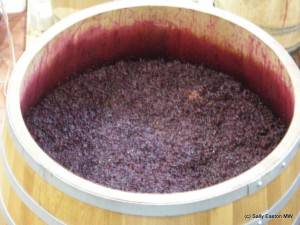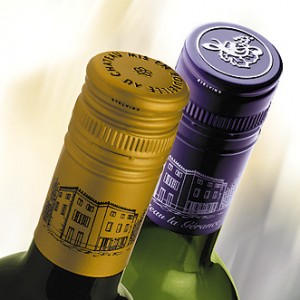Reduction – winemaker or closure?
A version of this article first appeared in Drinks Business, February 2013.
It is well reported, for example through various closure trials undertaken by the Australian Wine and Research Institute (AWRI), that bottling the same wine under different closures results in wines of different attributes after a year or two in bottle, including oxidation and reduction faults.
It’s been a long time since the original 1999 AWRI study started identifying reduced (volatile sulphur) notes of rubber, flint, struck match under bottles closed with screwcap. Understanding of sulphide chemistry has come a way since then, so can we really justify the perpetuation of the idea that screwcaps cause reduction?
Winemaking related?
 Fundamentally, reduction is a winemaking issue. But, and there’s invariably a but (where would the debate be otherwise), if the winemaking is not spot-on, reduction may be more prone to develop under some closures rather than others, typically those with very low oxygen transmission rates (OTRs), of whatever manufacture; mostly screwcaps, usually tin-lined. Brian Croser of Tapanappa in Australia said “modern winemaking, with its understanding of sulphide chemistry can avoid reduction. It’s perfectly possible to make wines without problems from sulphide mercaptans and disulphides”, adding “there is no excuse for a wine to be made and put into bottle with sulphide evident, and it is happening less and less.”
Fundamentally, reduction is a winemaking issue. But, and there’s invariably a but (where would the debate be otherwise), if the winemaking is not spot-on, reduction may be more prone to develop under some closures rather than others, typically those with very low oxygen transmission rates (OTRs), of whatever manufacture; mostly screwcaps, usually tin-lined. Brian Croser of Tapanappa in Australia said “modern winemaking, with its understanding of sulphide chemistry can avoid reduction. It’s perfectly possible to make wines without problems from sulphide mercaptans and disulphides”, adding “there is no excuse for a wine to be made and put into bottle with sulphide evident, and it is happening less and less.”
Such sulphide issues can and do occur while the wine is maturing in bulk, which, Croser added “can be cured; there are mechanisms for doing this, including the addition of copper, and depending on whether its in sulphide form or disulphide form, the addition of ascorbic acid.”
Fellow Australian Christian Canute, winemaker and director at the family-run Rusden Wines in Barossa Valley agreed saying “The winemaker is 100% responsible for reduction” but with a serious caveat, having put one of his red wine blends under screwcap in 2005, he added wryly “we have never had a problem with hydrogen sulphide [rotten eggs] in any of our wines through the winemaking process for over 15 years, it only reared its head when we started trialling screwcaps and developed entirely in the bottle after ‘screwing’ the Driftsand for five years.”
In some aspects there may have been a coincidence of factors – the medium-term trend to make wine more reductively has occurred alongside the increasing use of closures that exclude more oxygen, i.e. screwcaps, both with the slightly more permeable liner Saranex, and the less permeable liner SaranTin – see Chatonnet chart. Dr. Paolo Lopes, specialist researcher into closures and Amorim’s R&D oenological research manager said “it seems that those countries which developed a more reductive style in their wines are more prone to reduction, [thus] winemaking that promotes full oxygen protection of must and wine throughout winemaking will generate wine that will be more prone to reduction after bottling.”
Schematic diagram showing range of OTRs by closure type
Source: Chatonnet, P. Reduction in wine in relation to post-bottling evolution – influence of closures. Presentation at LIWF, 2012.
Croser makes a direct link, saying “reduction in bottle relates to the use of metal closures [screwcaps]. Wines are being put into bottle with the potential, under very low redox conditions – a very reduced state where oxygen is excluded – for the sulphide to reappear under screwcap.” But, he emphasised “this can be avoided by putting wine into bottle at the right redox potential. So it is possible to bottle under the most anaerobic screwcap [SaranTin liner] without sulphides appearing.” But he also intimated it was quite easy for reduction to happen, if someone was not completely on top of their sulphide game.
Closure-related?
 So is the closure implicated? Lopes said “reduction is a winemaking issue where the closure plays an important role … the use of airtight closures such as screwcaps leads to reductive development of wines and ultimate to full reduction.”
So is the closure implicated? Lopes said “reduction is a winemaking issue where the closure plays an important role … the use of airtight closures such as screwcaps leads to reductive development of wines and ultimate to full reduction.”
Evidently, Lopes added “the winemaker can adjust and prepare the wine [before bottling] differently in order to mitigate reduction under screwcap. By doing this the winemaker is producing a wine adapted to screwcap, when the closure must adapt to the wine created by the winemaker.” Indeed one of Laroche’s early learnings, having started using screwcaps on all their Chablis’ in 2001, was “the serious impact on the sulphur dioxide regime, you need less sulphur dioxide” said Sandrine Audegond, head of wine communication for the company. Twelve years later, she added “it’s a lot about experience, we test screwcaps often, keep many samples, technically the decision is based mainly on experience.”
It could be that closure may be more implicated further up the bottle-longevity scale. Few suggest that screwcaps are anything other than one good option for rapid turnover, easy-drinking, entry-level, fruity, unoaked styles of wine of any colour … unless perhaps the winemaking is not pinpoint precise. But the debate opens up for wines intended for bottle age. Lopes said “it is clear that wine development is more a reductive than oxidative phenomenon.” Previous research by him and his colleagues in 2009 showed that some negative sulphur compounds formed during fermentation “can increase in wines after bottling when wines have airtight conditions such a bottle-ampoule [sealed glass], or with closures with very low OTRs, as exhibited by screwcaps.”
Therefore, he added “the closure can play an important role in wine post-bottling development either through its oxygen transmission or chemical properties. Closures that release some amount of oxygen from its structure such as cork stoppers or are oxygen permeable such as synthetics usually prevent the increase in reductive compounds after bottling.”
Synthetics closure manufacturer Nomacorc’s oenological research manager, Dr. Maurizio Ugliano agreed that closures can play a deliberate role, “adding another level of control to the winemaking process.” He went as far as to say “the closure is one of the most effective ways to control reduction. Oxygen is a modulator of reduction during bottle ageing, so having a range of oxygen permeability values (OTRs) allows you to tailor your closure option depending on the likelihood that wine will become reductive with time.”
However Croser said it was a separate issue: “allowing oxygen into wine through the closure isn’t just to get rid of unwanted sulphide compounds. You shouldn’t have to do that if the wine is made properly. [OTRs] are a sort of an answer to cork in allowing enough oxygen into the wine to allow a normal development.” Lopes argued a similar line, saying “most of the trials arising from peer-reviewed studies show that cork stoppers provide the most balanced wine development after bottling. Those wines sealed with corks keep varietal thiols (“good thiols”) responsible for fruit scents at a high level, but, at the same time, keep the deleterious “bad thiols” at very low levels.”
What is this ‘good’ and ‘bad’ reduction?
Is a little bit of reduction a good thing? Ugliano thinks so: “in certain regions, wine styles will benefit from touch of reduction, for example, Burgundy whites, or fume blanc Loire wines. These are part of a family of sulphur compounds that form smoky, mineral characters, contributing positively to the aroma of the wine.”
The bad reduction, Lopes said “is related to sulfides, disulfides, thioesters and heterocyclic compounds which smell very bad – onion, garlic, cooked cabbage, rotten eggs, rubber and putrefaction” which, he added can accumulate “throughout winemaking and post-bottling when the wines are submitted to strict anaerobic/reductive conditions.“ Hydrogen sulphide (H2S) is arguably the most important one of these smelling of rotten egg and sewage. Mmm.
The line between no reduction and bad reduction is a very narrow one though, Ugliano added. “In our studies, we found the difference in the amount of oxygen is very little, just 1-2mg/litre/year to go from no reduction through good reduction to bad reduction. So it becomes important to have a clear idea of what level of reduction the winemaker wants, and the closure will become a powerful tool to get as close as possible to this level in the wine.”
The newish skinny Aussie chardonnay style sometimes deliberately incorporates the flint, struck match and gunsmoke notes of reduction, though the likes of Mornington Peninsula winemaker Tom Carson of Yabby Lake rails against the idea that the closure may be implicated. Carson said “reduction and closures are not linked” retaining reduction as a winemaking issue, or choice, adding “reduction is certainly a positive, but like all wine elements it must be in balance. We strive to achieve a level of this complexity, but are wary of over doing it. It is a layer of complexity that suits well this cooler grown chardonnay and provides structure and a touch of savouriness to the palate.”
Michael Brajkovich, of Kumeu River in New Zealand, and founder member of the screwcap initiative, added “when a wine that is balanced in terms of its “reductive” characteristics is put into bottle, then in my experience the future development is quite normal and highly beneficial to the wine. It will develop the very correct bottle bouquet characteristics that are highly prized and sought after.”
Grape varieties implicated?
This idea of a little bit of beneficial reduction varies with cultivar. Croser said “in sauvignon blanc, riesling, muscats – the aromatic varieties – organic sulphide compounds are part of the aroma profile. They give the blackcurrant in sauvignon blanc for example, and if you fine sauvignon blanc with copper you reduce some of the really important aromatic notes.” These are the compounds that need to be preserved post-bottling.
Of the black varieties syrah is usually the one that sticks. Iain Munson, winemaker at JeanJean said “syrah just has the redox potential to go reduced. You might have to do a little more racking, and aerated racking. You can do copper treatment, and you make a judgement at the point of bottling.”
Sandrine Audegond, Head of wine communication for Laroche said “we produce red wine in south of France, at Mas La Chevalière, and syrah with a bit of ageing in barrel and screwcaps are not the perfect combination. Screwcap affects the structure, making it a bit tough and tight which isn’t our style. We’re happier with natural cork.”
Varietal individuality notwithstanding, Lopes said some “grape varieties are more prone to reduction than others. However, it was shown by several studies that wines sealed under screwcap develop towards reduction regardless of the grape variety.”
So, reduction is a winemaking issue. Yes. Closures are implicated. Apparently so.
Comments
2 Responses to “Reduction – winemaker or closure?”




June 30, 2013 at 8:15 am
Sulfate + sulfite is the major reservoir of sulfur in bottled wines, and the post-bottling lowering of the oxidation state of the wine can lead to the formation of minute amounts of hydrogen sulfide. Cork has the ability to absorb minute amounts of volatile sulfide compounds, and this is the reason that cork-sealed wines are mostly free of sulphide-like odours (SLO).
July 1, 2013 at 8:47 am
Thanks, as always John.